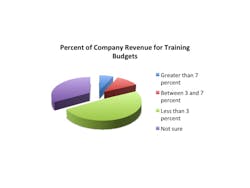The Slow Advance of New Training Methods
ARC Advisory Group recently conducted a survey of the oil and gas and nuclear energy industries to gain an understanding of their strategies for training personnel in operations. Respondents supplied information about their average budgets for training as well as the types of training employed.
Budgets for training among the respondents varied only slightly. Most participants indicated that they budgeted less than 3 percent of revenue for training; 35 percent budgeted more than three percent but less than 7 percent.
“Training budgets depend upon many factors such as the industry, the manufacturing facility, number of people who need training or re-training, and the type of training required,” says Janice Abel, a principal consultant at ARC. “The type of training covered in these budgets range from traditional classroom training, online training, gaming, generic simulation training, high-fidelity simulation training, immersive training and can even include avatars speaking to each other.”
The majority of respondents, 88 percent, indicated that the primary method of training they received was not among the structured types of training mentioned by Abel. Instead, the type of training most often received by respondents was on-the-job training. However, about 50 percent did receive some instructor-led classroom training, and slightly more than 20 percent received some form of computer-based training.
ARC has been a proponent of computer training as a supplement to on-the-job and classroom-based training, especially 3D simulation training. ARC’s support of 3D simulation training stems from data that suggest this method has a 78 percent retention rate.
3D simulation training software, which has long been used to train pilots to operate controls, allows operators to experience simulated emergency events for safe training. It helps provide response training without real risk of catastrophe, for which there always is potential within the energy industries. However, only seven percent of respondents indicated having such programs, and more than 90 percent indicated having zero interest. This is likely due to the fact that 3D simulation software is only beginning to make its mark in industrial settings.
This perspective will likely change in the near future, Abel says. The software programs are becoming more affordable, and changing age demographics are introducing a more tech savvy workforce. As the workforce evolves, the training methods for training it also should evolve. Otherwise both companies and consumers are at risk.

